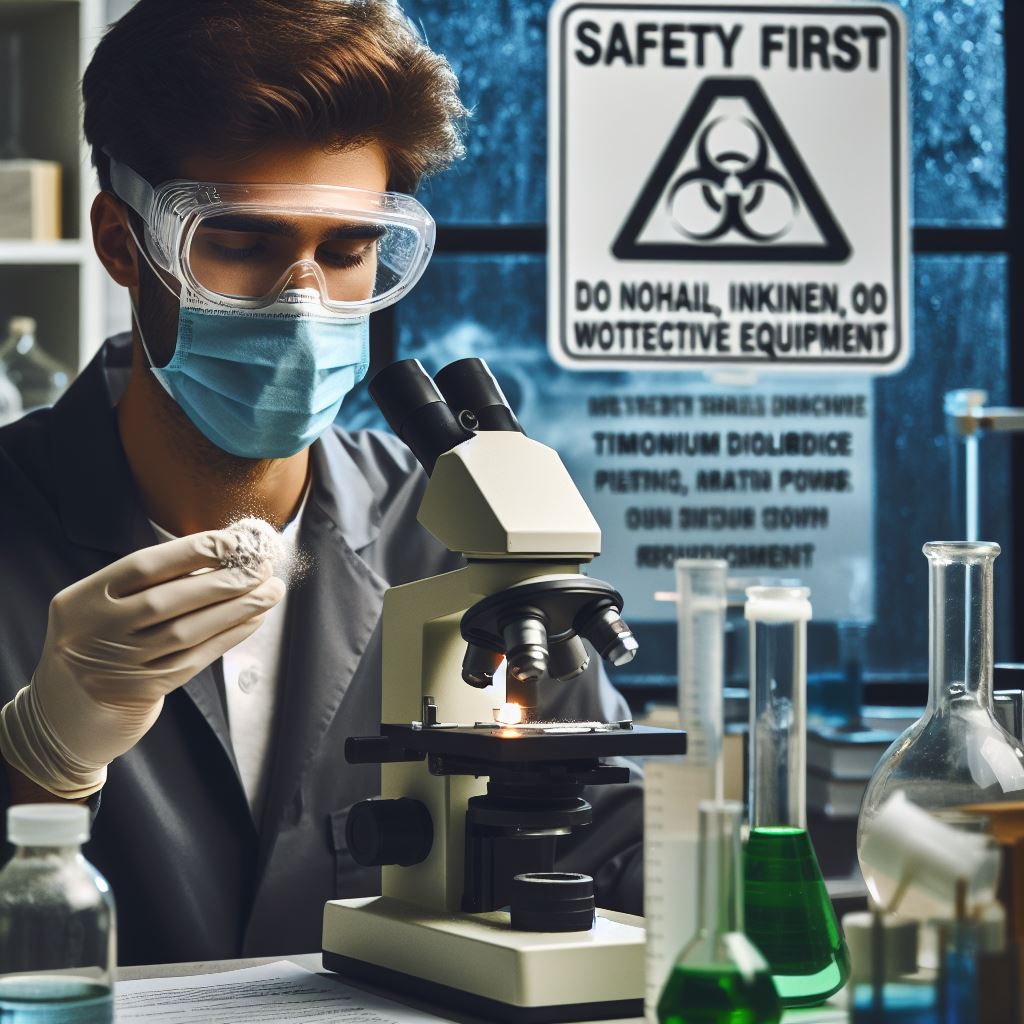Titanium Dioxide Safety is crucial in industries because of its opacity. Exposure risks demand careful consideration, especially in occupational settings. Inhalation concerns necessitate safety measures like respiratory protection and ventilation. The compound’s dual role in food and cosmetics complicates safety, with particle size considerations in sunscreens. Ongoing research explores long-term health implications, emphasizing the importance of safety protocols in various applications. Responsible and sustainable utilization requires informed practices and vigilance across diverse industries.
Table of Contents
ToggleIntroduction to Titanium Dioxide and Its Common Uses
Titanium dioxide (TiO2) is a versatile compound with various applications across various industries. Titanium dioxide, a naturally occurring oxide of titanium, exists in minerals and serves various purposes due to its exceptional opacity and brightness. This compound has gained renown for its capacity to reflect and scatter light, thereby playing a crucial role in numerous products.
Common Uses of Titanium Dioxide:
- Paints and Coatings: Titanium dioxide is a primary component in paints, providing opacity and enhancing the coverage of colored pigments.
- Cosmetics: The cosmetic industry uses it in sunscreens, foundations, and other skincare products for its UV-blocking properties.
- Food and Pharmaceuticals: Used as a white pigment in food items, pharmaceuticals, and toothpaste, adding brightness and whiteness.
- Plastics and Paper: Incorporated into plastics, paper, and certain textiles to enhance their brightness and strength.
Safety Concerns Surrounding Titanium Dioxide

Despite its widespread use, titanium dioxide has been a subject of safety concerns, particularly regarding potential health risks associated with exposure.
Key Safety Concerns:
- Inhalation Risks: Fine particles of titanium dioxide can become airborne during manufacturing processes or use, posing inhalation risks.
- Carcinogenicity: Some studies have suggested a possible link between the inhalation of titanium dioxide particles and respiratory issues, raising concerns about its carcinogenic potential.
Scientific Research on Titanium Dioxide Safety
Scientific research has been instrumental in understanding the safety profile of titanium dioxide. Researchers have conducted a multitude of studies to assess its impact on human health and the environment.
Research Highlights:
- Toxicology Studies: Researchers have conducted various toxicology studies to assess how titanium dioxide affects different organs and systems within the human body.
- Epidemiological Research: Researchers have conducted studies to analyze the health outcomes of individuals exposed to titanium dioxide in occupational settings, aiming to assess any potential associations.
- Environmental Impact Studies: Research exploring the environmental fate and impact of titanium dioxide nanoparticles has been vital in understanding its ecological footprint.
Potential Health Risks of Titanium Dioxide Exposure
Understanding the potential health risks associated with titanium dioxide exposure is crucial for informed decision-making and risk management.
Health Risks:
- Respiratory Issues: Inhalation of fine titanium dioxide particles may lead to respiratory problems, with concerns about long-term exposure contributing to chronic conditions.
- Skin Irritation: In some cases, skin irritation may occur, particularly when in direct contact with products containing high concentrations of titanium dioxide.
Regulatory Measures Ensuring Titanium Dioxide Safety
Regulatory bodies worldwide play a pivotal role in establishing guidelines and standards to ensure the safe use of titanium dioxide.
Oversight:
- Occupational Safety and Health Administration (OSHA): In the United States, OSHA sets permissible exposure limits for titanium dioxide in workplace environments.
- European Chemicals Agency (ECHA): ECHA has classified titanium dioxide as a substance suspected of causing cancer through inhalation, leading to regulatory actions and mandatory labeling.
- Food and Drug Administration (FDA): The FDA regulates the use of titanium dioxide in food and cosmetics, ensuring it meets safety standards.
Conflicting Viewpoints and Controversies
The safety of titanium dioxide has sparked debates and controversies, with differing viewpoints among scientists, regulatory bodies, and industries.
Controversies:
- Carcinogenicity Debate: The classification of titanium dioxide as a potential carcinogen through inhalation has been a subject of controversy, with ongoing discussions about the interpretation of scientific evidence.
- Regulatory Disparities: Different countries have adopted varying approaches to regulate titanium dioxide, leading to discrepancies in safety standards and labeling requirements.
Industries and Products Using Titanium Dioxide

The versatility of titanium dioxide has led to its extensive use across various industries, contributing to the functionality and aesthetics of diverse products.
Prominent Industries and Products:
- Paint and Coatings Industry: Titanium dioxide is a cornerstone in the formulation of paints, providing opacity and durability.
- Cosmetic and Skincare Products: Found in sunscreens, foundations, and other cosmetic products, it offers UV protection and enhances product aesthetics.
- Food and Beverage Sector: As a food additive, titanium dioxide is prevalent in candies, chewing gum, and other items to achieve a white color.
- Plastics and Textiles: Incorporated into plastics, textiles, and paper products to improve their appearance and durability.
Safety Precautions for Titanium Dioxide Use
Individuals and industries can adopt various safety measures to minimize the potential risks associated with titanium dioxide exposure.
Safety Guidelines:
- Ventilation: Ensuring adequate ventilation in workplaces using titanium dioxide helps reduce the risk of inhalation exposure.
- Personal Protective Equipment (PPE): The use of appropriate PPE, such as masks and gloves, can protect individuals working with titanium dioxide.
- Labeling and Consumer Awareness: Clear labeling on products containing titanium dioxide enables consumers to make informed choices, while industry practices should prioritize transparency.
Importance of Further Research on Titanium Dioxide Safety
Continued research is essential to enhance our understanding of titanium dioxide safety, address existing knowledge gaps, and develop effective risk management strategies.
Research Needs:
- Long-Term Health Effects: In-depth studies examining the long-term health effects of titanium dioxide exposure are crucial for establishing comprehensive safety guidelines.
- Environmental Impact: Research focusing on the environmental impact of titanium dioxide, especially in nanoparticle form, is vital for sustainable and responsible use.
Additional Topics
Chemical Properties of Titanium Dioxide:
Titanium dioxide exists in various crystalline forms, with the rutile and anatase phases being the most common. These different forms exhibit distinct properties, influencing their applications and safety considerations.
Different Forms and Applications:
- Rutile Form: Industries widely use this form in paints and coatings due to its excellent UV-absorbing capabilities.
- Anatase Form: Commonly found in cosmetics and skincare products, the anatase phase provides effective UV protection.
Environmental Impact:
The environmental impact of titanium dioxide nanoparticles is a growing concern. These particles can enter ecosystems through various pathways, potentially affecting aquatic organisms and soil quality.
Exposure Routes:
People can expose themselves to titanium dioxide through inhalation, ingestion, or skin contact. Understanding these exposure routes is crucial for assessing the associated risks accurately.
Carcinogenicity Studies:
Research on the carcinogenic potential of titanium dioxide has yielded varied results. Some studies suggest a link between inhalation exposure and lung cancer, while others emphasize the importance of particle size and surface characteristics in determining toxicity.
Mechanisms of Adverse Health Effects:
The mechanisms through which titanium dioxide may cause adverse health effects include oxidative stress, inflammation, and potential DNA damage. Understanding these mechanisms is essential for developing targeted safety measures.
Global Regulatory Landscape:
Different countries have adopted diverse regulatory approaches to manage titanium dioxide safety. Harmonizing these regulations can facilitate international trade while ensuring consistent safety standards.
Industry’s Role in Safety:
Industries utilizing titanium dioxide bear the responsibility of implementing robust safety measures, conducting thorough risk assessments, and exploring alternative substances or technologies.
Alternatives to Titanium Dioxide:
In certain applications, alternative substances or technologies may serve as safer alternatives to titanium dioxide. For instance, some eco-friendly pigments and UV-blocking agents offer comparable performance with lower environmental and health risks.
Follow-Up Questions
1. Can you provide more details on the potential health risks associated with inhalation of titanium dioxide particles?

Certainly. The inhalation of fine titanium dioxide particles poses a significant concern, especially in occupational settings. Airborne particles of titanium dioxide can be easily inhaled into the respiratory system, potentially leading to adverse health effects. The primary risk involves the potential for respiratory issues, including but not limited to lung irritation and inflammation. Fine particles can reach deep into the lungs, and ongoing research aims to ascertain if long-term exposure might contribute to chronic respiratory conditions. For individuals working in industries where titanium dioxide is used, adhering to proper safety protocols, including the use of respiratory protection, is crucial to minimize inhalation risks.
2. How do regulatory agencies determine the acceptable levels of titanium dioxide in consumer products?
Regulatory agencies, such as the FDA and ECHA, establish acceptable levels of titanium dioxide in consumer products through a rigorous assessment of scientific data. These agencies consider a range of factors, including toxicological studies, exposure assessments, and risk evaluations. The acceptable levels are typically set to ensure that exposure to titanium dioxide does not pose undue health risks to consumers. The regulatory process involves collaboration with scientific experts and stakeholders to gather the most current and relevant information. It’s important to note that these acceptable levels may vary between different countries and regions, reflecting diverse regulatory approaches and risk management strategies.
3. What are some of the challenges faced in researching titanium dioxide safety?
Researching titanium dioxide safety comes with its set of challenges. One major challenge is the complexity of exposure scenarios. Titanium dioxide is used in a wide range of products, and exposure can occur through various routes such as inhalation, ingestion, and skin contact. Studying the diverse applications of titanium dioxide and its associated risks requires a multidisciplinary approach.
Another challenge is the need for long-term studies to understand chronic health effects. Many existing studies focus on short-term exposure, and there is a growing need for research that investigates the cumulative and long-term impact of titanium dioxide on human health.
Additionally, the dynamic nature of nanoparticles poses challenges in terms of tracking their behavior in the environment and their potential transformation over time. This requires sophisticated methodologies and instrumentation.
Despite these challenges, ongoing research efforts are essential to provide a comprehensive understanding of titanium dioxide safety and guide regulatory decisions.
4. Can you explain the difference between titanium dioxide used in food products and those used in cosmetics?
The titanium dioxide used in food products and cosmetics is generally the same compound, but the applications and forms may differ. In both cases, the aim is to utilize titanium dioxide’s white pigment properties for aesthetic and functional purposes.
Food products incorporate titanium dioxide as a food additive to offer whiteness and opacity. It is prevalent in candies, chewing gum, and other confectionery items. The primary concern in this context revolves around particle size, with larger particles generally considered safer for ingestion.
In cosmetics, titanium dioxide serves a dual purpose. Manufacturers use it for its white pigment properties, providing a desirable color in products like foundations and sunscreens. Additionally, it is valued for its UV-blocking capabilities, offering protection against harmful ultraviolet (UV) rays. Cosmetic products often feature smaller particle sizes, especially in sunscreens where nanoparticles are utilized for enhanced UV protection. This difference in particle size can influence the potential for skin penetration and absorption, raising considerations about the safety of nanoparticles in cosmetics.
5. Are there any ongoing efforts to develop safer alternatives to titanium dioxide?

Yes, there are ongoing efforts to explore and develop safer alternatives to titanium dioxide, especially in applications where concerns about its safety persist. Researchers and industries are actively investigating alternative pigments and UV-blocking agents that can provide similar functionalities without
the potential health and environmental risks associated with titanium dioxide. Some of the alternatives being explored include:
- Zinc Oxide: Zinc oxide is a common alternative in sunscreens. It provides effective UV protection and is considered safer for skin use. Additionally, it has less environmental impact than certain titanium dioxide forms.
- Iron Oxides: Cosmetics utilize iron oxides, especially in the form of red, yellow, and brown pigments, as alternatives. These pigments provide a broad spectrum of colors and are generally considered safe.
- Eco-friendly Pigments: Researchers are investigating pigments derived from natural sources, such as plant-based compounds or minerals, as potential substitutes for titanium dioxide in various applications.
- Nanostructured Materials: Innovative materials with nanostructures are being explored to mimic the optical properties of titanium dioxide while minimizing potential risks. These materials aim to provide the desired functionality without the same concerns about particle size and toxicity.
- Polymeric Films: In some applications, polymeric films are being explored as a substitute for titanium dioxide, offering a barrier effect and enhancing product properties without the use of nanoparticles.
While these alternatives show promise, it’s essential to conduct thorough assessments of their safety and performance before widespread adoption. Additionally, the industry’s acceptance and regulatory approval play a crucial role in the successful implementation of these alternatives.
6. How can consumers identify products that contain titanium dioxide?
Identifying products containing titanium dioxide can be challenging for consumers, as it is often listed under different names on product labels. Here are some common names used for titanium dioxide in ingredient lists:
- Titanium Dioxide (CI 77891): This is the standard name for titanium dioxide and is often found in cosmetics and personal care products.
- E171: In the European Union, titanium dioxide used as a food additive is labeled as E171. This designation may appear on food product labels.
- Pigment White 6: In the context of paints and coatings, titanium dioxide may be referred to as Pigment White 6.
Consumers can look for these names on the ingredient list of products. However, it’s important to note that not all products containing titanium dioxide may explicitly list it, especially in the case of mixtures or formulations where it is a component of a larger ingredient.
For individuals concerned about titanium dioxide exposure, choosing products labeled as “titanium dioxide-free” or opting for alternatives with different pigments may be a precautionary measure. Additionally, consulting product reviews, seeking information from manufacturers, and staying informed about regulatory developments can assist consumers in making informed choices.
7. Can you discuss any recent advancements in the understanding of titanium dioxide safety?
Recent advancements in the understanding of titanium dioxide safety have focused on several key areas:
- Nanoparticle Characterization: Advanced techniques for nanoparticle characterization are providing more detailed insights into the size, shape, and surface characteristics of titanium dioxide nanoparticles. This helps researchers better understand their behavior and potential interactions within biological systems.
- In Vitro Studies: The development of sophisticated in vitro models allows researchers to simulate the effects of titanium dioxide exposure on human cells and tissues. This enables a more targeted assessment of potential health impacts without relying solely on animal studies.
- Environmental Fate and Transport: Ongoing research is examining the environmental fate of titanium dioxide nanoparticles, especially in aquatic ecosystems. Understanding how these particles behave in the environment contributes to assessing their ecological impact.
- Epidemiological Studies: Researchers are conducting long-term epidemiological studies to evaluate the health outcomes of individuals with prolonged exposure to titanium dioxide, particularly in occupational settings. These studies aim to provide more conclusive evidence regarding potential health risks.
- Alternatives and Green Chemistry: Advances in green chemistry are driving the exploration of alternative pigments and materials that can replace titanium dioxide in various applications. This aligns with the growing emphasis on sustainability and reducing the environmental impact of industrial processes.
While these advancements contribute to a more nuanced understanding of titanium dioxide safety, it’s essential to acknowledge that research in this field is ongoing. As new findings emerge, they will continue to shape our understanding of the compound’s safety profile and inform regulatory decisions.
Key Takeaways 1
- Titanium Dioxide Basics: Industries widely use titanium dioxide, recognizing it for its opacity and brightness. It finds applications in paints, cosmetics, food products, plastics, and various other sectors.
- Safety Concerns: The safety concerns surrounding titanium dioxide primarily revolve around inhalation risks and potential carcinogenicity. Fine particles, when airborne, can pose health risks upon inhalation.
- Scientific Research: Scientists have conducted scientific research, including toxicology studies, epidemiological research, and environmental impact studies, to comprehensively assess the safety of titanium dioxide.
- Health Risks: Potential health risks of titanium dioxide exposure include respiratory issues and skin irritation. The debate on its carcinogenicity continues, with varying study results.
- Regulatory Measures: Regulatory agencies worldwide, such as OSHA and ECHA, establish guidelines and permissible exposure limits to ensure titanium dioxide safety. Varying approaches and classifications exist, contributing to controversies.
- Industries and Products: Titanium dioxide is extensively used in paint and coatings, cosmetics, food products, and plastics, among other industries.
Key Takeaways 2
- Safety Precautions: Adequate ventilation, personal protective equipment, and clear labeling are essential safety precautions for individuals working with titanium dioxide.
- Need for Further Research: Continued research is crucial to address knowledge gaps, particularly regarding long-term health effects and the environmental impact of titanium dioxide.
- Chemical Properties and Forms: Titanium dioxide exists in different crystalline forms, with rutile and anatase being common. These forms have distinct properties influencing their applications.
- Alternative Substances: Ongoing efforts explore alternatives to titanium dioxide, including zinc oxide, iron oxides, eco-friendly pigments, nanostructured materials, and polymeric films.
- Consumer Awareness: Consumers can identify titanium dioxide in products by checking ingredient lists for names like Titanium Dioxide, E171, or Pigment White 6. Choosing titanium dioxide-free products or alternatives is a precautionary measure.
- Recent Advancements: Advances in nanoparticle characterization, in vitro studies, environmental fate assessment, epidemiological studies, and the exploration of alternative materials contribute to advancing our understanding of titanium dioxide safety.
In conclusion, the safety of titanium dioxide is a complex and multifaceted issue, involving scientific, regulatory, and societal considerations. While its versatility is undeniable, ongoing research and a commitment to responsible use are essential to navigate potential risks and ensure the continued safe application of titanium dioxide across various industries.





